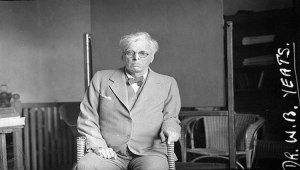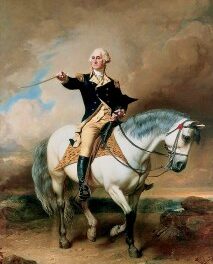We support our Publishers and Content Creators. You can view this story on their website by CLICKING HERE.
Yeats reminds us that sustaining civilization entails remembering past actors and embodying the characteristics that we admire in them.
When we set out to affirm and defend what we describe as “civilization” it may seem reasonable to take an active stance: It is important to actively preserve and promote that which we deem important in our societies. Certainly, this view is necessary. Hannah Arendt famously lamented the shift from an “active life” (vita activa) in Classical antiquity to a “contemplative life” (vita contemplativa) that emergedwith the advent of history. As she argued, the recording of major events and their actors made it so that readers of history no longer admired these figures for their actions, but for their place in the books. Likewise, what we look for in admirable figures as sources of inspiration became an antiquarian endeavor that entails reading old stories of bygone ages, rather than demanding these attributes of our own leaders and ourselves. What we choose to emulate in these figures, then, inspires us for the wrong reasons: fame and legacy. The citizen, Arendt laments, has ceased to know how to participate in his political society.
Perhaps Arendt overlooks the role that a contemplative life plays in the development of active men. Indeed, prudence—which allows us to discern the proper course of action for a given occasion—is itself a virtue predicated upon thought. Not enough emphasis is placed on the role that silence plays—and has played—in building and sustaining civilization. By “silence” I consider the myriad actions that require quiet contemplation and meditative engagement with the world in order to fully make sense of it and, consequently, act upon it. Silence is not, in this case, a form of abstaining from or protesting the world; rather, a method of action that prioritizes thought before action. Counterintuitive as this concept may be, it is the basis of one of W. B. Yeats’ most famous poems, “Long-Legged Fly.” The poem is a classic, and it is well worth reading and analyzing for its lingering message and beautiful imagery.
From the outset, the poem introduces the topic of civilization, and so it is necessary to initially venture to understand the packed term. We may not know what is meant by civilization for Yeats, but it is important to acknowledge that he writes his poem from a historical perspective. Each stanza cites a recognizable figure from the past and reimagines their impact on history through their actions in silence. This fact alone demonstrates the contingency that civilization has on history—itself a silent field that speaks only to those willing to listen to it—for without it, civilization would not exist. Yeats reminds us that sustaining civilization entails dually remembering past actors as well as embodying those very characteristics that we admire in them. In this sense, “civilization” in Yeats’ understanding of the term contains a historical dimension that serves a wider purpose than telling us stories of grand men and women. These stories, Yeats’ poem tells us, can be didactic if we read them for their deeper lessons about life and not just their distant anecdotal novelty.
But surely civilization is more than history: what else, then, comprises this vast term? More importantly, what transforms civilization from a passive series of recorded events into an active endeavor in which we all partake on a daily basis? We can begin to explore the poem further to find out. The first stanza takes us back to the Roman Republic, and grants us a glimpse into the mind of one of the most strategic military minds of the time:
That civilisation may not sink,
Its great battle lost,
Quiet the dog, tether the pony
To a distant post.
Our master Caesar is in the tent
Where the maps are spread,
His eyes fixed upon nothing,
A hand upon his head. (1-8)
Several concepts stand out in these opening lines. Namely Yeats’ association of civilization with a “great battle” (2) that can either be won or lost. Immediately, Yeats indicates that men have an active role in preserving civilization; the way in which to accomplish this task we do not know. We learn, however, that Julius Caesar is the figure in this first stanza who is concerned with winning a battle in the name of civilization. In this sense, civilization for Caesar represents the Roman Republic and its achievements—physical, political, and intellectual. In order for Caesar to win this battle, Yeats tells us, it is necessary to “quiet the dog” and “tether the pony / To a distant post” (3-4). In other words, it is necessary to remove distractions from his surroundings, even to silence them, since Caesar is isolated in a tent and is in the middle of strategizing—a cue given to us by his maps being “spread” (6) across his tent. Yet, Caesar is not strategizing by using the maps at his disposal. His eyes are “fixed upon nothing” (7) as he sits with “a hand upon his head” (8). Up to this point, we are not clear about what the emotions behind Caesar’s actions are. What we do know is that he is not present in his physical setting, as his eyes are not looking at anything around him. Yeats introduces a refrain of sorts (notice the italics in the original poem) in the following 2-line stanza that clarifies the aforementioned scene:
Like a long-legged fly upon the stream
His mind moves upon silence. (9-10)
These two lines are repeated three times in the poem after each stanza that describes a historical scene, indicating that these lines are Yeats’ observation or take-away about the three events that he describes in the poem. To be sure, it is odd to switch from historical anecdotes to animal imagery, especially that of a fly. The choice of a long-legged fly as the animal of comparison to the Roman general is itself meaningful. A fly is an insignificant creature, especially one situated upon a stream. The stream is a larger and much more powerful entity, yet the image of a stream also beckons calmness. The fly does not try to fight the stream, but only moves with it. Yeats is bringing to our mind an image, then, that contrasts the setting in which Caesar finds himself. The surroundings—dogs, horses, scattered maps, impending battles—are all chaotic forces; yet Yeats is interested in what is taking place inside Caesar’s mind, which he depicts as calmness and contemplation. The emphasis on silence, moreover, is central to the imagery because it is a necessary condition for Caesar to access this calmness.
The rest of the poem continues in this fashion, with references to particular anecdotes in history and figures who have shaped the course of civilization through their actions that are rooted in moments of silence. Yeats includes Helen of Troy and Michelangelo as two other figures that relied on silence for their own development. In the case of the Italian master, for example, painting the Sistine Chapel required utter silence—“no more sound than the mice make” (27)—in order to concentrate on his work of art. The process of creating art, Yeats implies, is a process that relies on the same form of mental tranquility as military strategizing. It is clear to Yeats that silence plays an essential role for statesmen and artists alike, but silence is more than a tool that allows a given figure to triumph. One of the stanzas in the poem describes a young Helen of Troy, whose silence enhances her beauty all the more. In this stanza, Yeats describes silence as a virtue that itself possesses an aesthetic quality. “Long-legged fly” explores three facets of silence: its effects on a strategizing general, on a beautiful woman, and on an artist. Despite how different these three figures are, Yeats finds a point of commonality in their embodiment of silence.
How might this poem speak to our contemporary qualms with the state of civilization? For one, Yeats tells us that civilization was largely built by figures who understood the need for silence, and this is perhaps something that we have lost in our modern world, replete with sources of entertainment in every corner. Silence intimidates us. We would rather pull out our phones on the train, or while waiting in line, than take the opportunity to look around us. We would rather listen to music than handle silence rather than listen to our surrounding. Silence, Yeats tells us, is something that one must find as escape only through initial engagement in the world. In other words, all three figures in Yeats’ poem find their solace within their respective surroundings. The problem with our modern culture of entertainment, then, is that it deprives us of this necessary first step that is living in the world in order to ascend to this second step—finding silence—which entails a momentary escape from the world to better elucidates our actions on earth. Yeats’ poem is a helpful reminder that even the most illustrious actors in history relied on silence for their development. This observation is not insignificant when we ask ourselves about the state and future of our shared civilization.
This essay was first published here in August 2021.
The Imaginative Conservative applies the principle of appreciation to the discussion of culture and politics—we approach dialogue with magnanimity rather than with mere civility. Will you help us remain a refreshing oasis in the increasingly contentious arena of modern discourse? Please consider donating now.
The featured image is a photograph of W.B. Yeats from the National Library of Ireland on the Commons. This file is in the public domain, courtesy of Wikimedia Commons.
Share This Story, Choose Your Platform!
Go to Top

 Conservative
Conservative  Search
Search Trending
Trending Current News
Current News 






